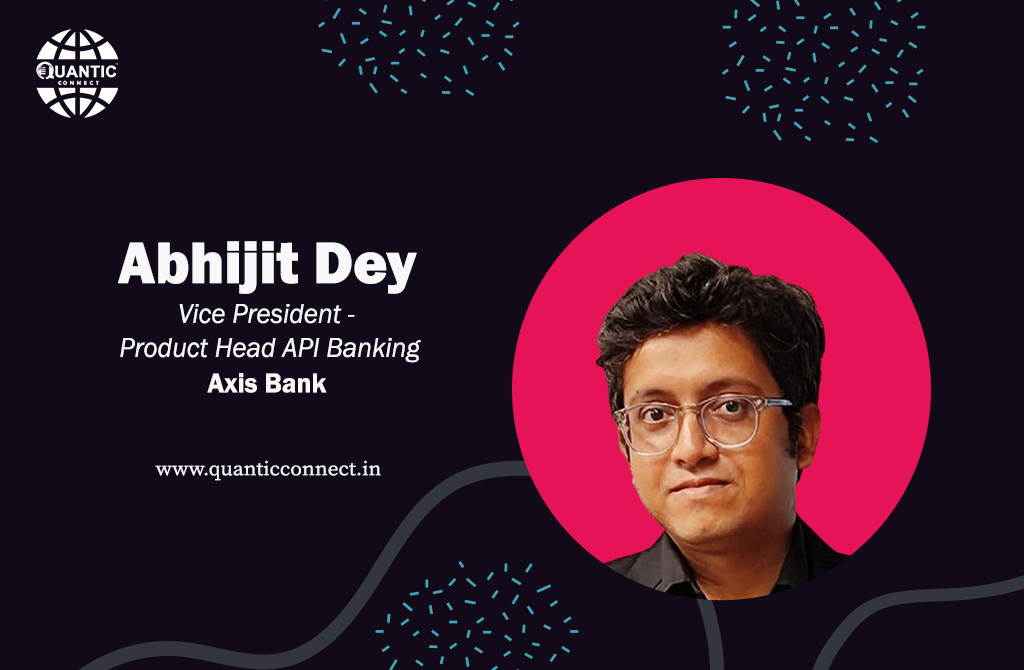The API-first method, as the name implies, prioritizes Application Programming Interfaces (APIs) in application development. Before developing the remainder of the program, application developers create and implement the API interface. Before beginning the development process, developers must establish how APIs can meet business needs.
To gain deeper insights into API first architecture’s role in BFSI, Quantic recently had the privilege of interviewing Mr. Abhijit Dey, the esteemed Vice President – Product Head API Banking of Axis Bank. He is an experienced Product Head with a demonstrated history of working in the BFSI sector. Abhijit is skilled in API management and API monetization and has created Open API framework for banks.
Guiding this engaging conversation is Mr. Marquis Fernandes, who spearheads the India Business at Quantic India in a discussion with Mr. Abhijit Dey who is the Vice President and Product Head API Banking at Axis Bank. Together, they explore the intriguing world of Axis Bank, shedding light on its methodologies to foster innovation. This insightful discussion promises to unveil valuable insights for banks seeking to manage their infrastructure with API first architecture. The views expressed by Abhijit Dey in this article are entirely personal and has no bearing with his organisation.
How API-first architecture allows BFSI organizations to quickly adapt to changing market demands, launch new products and services, and foster innovation?
In the last decade we over witnessed massive amount of digitization across Industries; BFSI will come on top 3 of such industry paradigms where Digitization is being implemented most rapidly. API and Data are the two most critical components for this digitization in BFSI; if Data is the fuel, then the API will be the most important currency of the Digital economy. API-First is an approach that most of the BFSI players have adopted to accelerate the development life cycle of every large and complex transformation program. As the name suggests, in this approach API is key and leads the entire enterprise architecture to a democratized environment where a non-tech member can own up the transformation programs.
In this competitive world of digital business, launching a product as per the GTM strategy and be adaptive to the market change is very important. The key principles of API First strategy will ensure a healthy growth and adherence to the organization’s GTM strategy. Conformance, Scalability, Stability and Monitoring are the keys for any API-First strategy. By implementing these principles in API development, we end up building API products which in turn opening new channels for sourcing and servicing our customers.
How AI can help you grow your API First architecture in BFSI?
In API First architecture, API Discovery is very important at the outset of any new digital journey build up. Mostly, in BFSI we have more than thousands APIs but to pick the right API for the right use case is a challenging and time consuming activity. AI can play major role in it, an AI driven API discovery platform can help product managers to identify the right APIs and map it in the correct placeholders of the journey. Incrementally we can use AI for building the Swaggers and API documentation for the newly built APIs.
On Open APIs paradigm, it is important to provide same discovery feature with relevant suggestive APIs to end consumers. Here AI can help us big, as the developer communities are always prone to be allured by new age tech.
Use cases of AI-powered APIs in BFSI, such as fraud detection, risk assessment, and personalized financial recommendations.
The other major use cases of AI would be on the Information Security end as the number of digital transactions are increasing manifold and digital adoption among customers are very high, it’s evident that the propensity of Fraudulent activities have also increased. Leaders in this area are cognizant of this fact that there are reputation and financial loss for all these fraudulent and anomalies. Real time transaction monitoring and transactional behavioural analysis can help us in forecast the Day zero attacks, here AI led security tools can help us in forecasting such scenarios. Change in customer’s transactions and service queries patterns can be detected by the AI algorithms followed by some alarms to the system.
Credit Risk assessment is also a major concern as more STP journeys are coming up for lending products; nowadays we have less touch points to assess the customers for underwriting. AI based underwriting tools are proven to be a major help here as in the runtime only we are assessing the risk factors. For, PFMs the predictive analysis based on customer’s spending and investment pattern can be derived by the AI algorithms. There are players in the market offering AI driven PFM platforms and the adoption is very high among the customers as the onboarding has become seamless.
Exploring the potential of natural language processing (NLP) and chatbots in API-first architecture for customer support and engagement.
Chatbots perhaps one of the initial use cases of AI in Banking and it’s still having the equal importance. With the latest advent of the Generative AI driven chatbots we started seeing brighter prospects of Chatbots; we are prudent of the fact that customers specially millennials are very inclined to the experiences of conversational banking. NLP driven chat tools guarantee lesser drop off rates and better query resolution efficacy.
Another significant use case of NLP is personalized messaging and offerings; gone are those days when a generic offer could please a customer. Nowadays personalized query resolution and bespoke offers are being offered by the AI-powered chatbots and that reducing the cost-of-service delivery.
The impact of AI on data security and privacy in API-first architecture.
On the outset I have mentioned about Data being the fuel of any Digital Business and thus it invariably become important to protect it from any abuse inside and outside the organization. In the Zero-based design stage of API First approach, a framework and governance is built which enables the Infosec stakeholders to asses the risk of the development for the very outset of the program. AI powered frameworks help the stakeholders to identify the severity of the APIs based on the contracts and signatures. Not only the Data security, but also Data quality can also be enhanced by AI. For example, AI can use the external sources and relevant information to increase the depth of data quality. Automatic cleansing and validation can be another use case of AI in Data quality.



